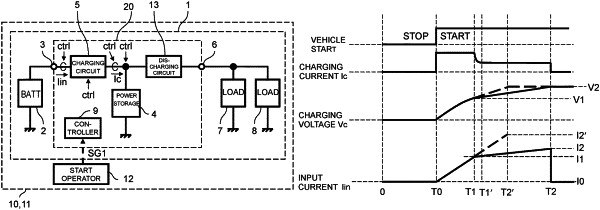| CPC H02J 9/061 (2013.01) [H02J 7/0063 (2013.01); H02J 7/0068 (2013.01); H02J 7/007182 (2020.01)] | 4 Claims |

|
1. A backup power system, comprising:
a battery;
a charging circuit electrically connected to the battery;
power storage configured to be charged by the charging circuit;
a first load electrically connected to the power storage;
a second load electrically connected to the power storage; and
a controller configured to control the charging circuit, wherein
the controller detects an input current at the charging circuit and a charging voltage at the power storage in response to a start signal input to the controller,
the controller causes the input current at the charging circuit to increase at a first rate of change in response to the start signal,
when the controller detects an increase in the charging voltage at the power storage up to a first voltage at which driving of the first load is possible, the controller causes the charging circuit to cause the input current at the charging circuit to increase at a second rate of change lower than the first rate of change, and
the charging circuit is controlled by the controller to cause the input current to increase at the second rate of change, and the charging voltage at the power storage increases up to a second voltage at which driving of both the first load and the second load is possible,
wherein a value of the input current at the charging circuit is higher during the charging at the second rate of change than the input current value during charging at the first rate of change.
|